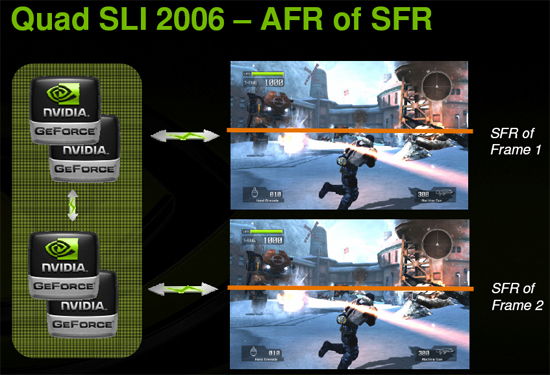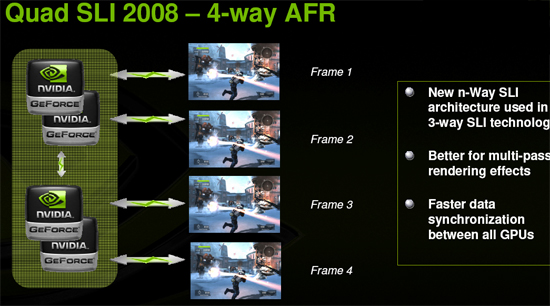Page 1 of 1
ATI tech from the past
Posted: Wed Oct 08, 2008 7:33 am
by DX
I was thinking that years ago that ATI (maybe I'm wrong and it was 3DFx) had some military sim that relied on tiling of the screen and that each gpu handled a small square of the screen. While perhaps not load balanced would allow many gpus to be applied and eliminate the prerendered limitation of three screen. It would allow then for in this case three or more GPUs to perhaps be more effectively used. As many benchmarks have shown that three simply are not worth the cost. With a board like
http://www.legitreviews.com/article/795/1/ that would allow the installation of four 4870x2 cards with two pairs crossfired have one pair render half the screen and the other pair render the other half or tile the screen with some factor related to the number of GPUs so that the tile load could be balanced.
It might not be cheap. But it would definitely give an eight gpu box a shot at being more of a possibility.
Yeah I'm just pining for an ultimate type rig that I have no hope of acquiring in the near future but that would be pretty cool =)
Re: ATI tech from the past
Posted: Wed Oct 08, 2008 7:50 am
by Apoptosis
Lucid "Hydra" Graphics kinda works like that with mix and matched cards rendering different things...
http://www.lucidlogix.com/technology/index.html
I can't think of a game that does it. You aren't thinking AFR are you? With AFR you can split the image into smaller squares, which are assigned to different cards... oh and AFR is Alternate Frame Rendering
Re: ATI tech from the past
Posted: Wed Oct 08, 2008 7:52 am
by DMB2000uk
You really like that mobo don't you

My basic understanding of crossfire/sli, was that it could work one of three ways:
- Tiling (it worked best if it was set up as a checkerboard pattern)
- AFR (each GPU works on rendering alternate frames)
- Load balancing (the screen is split up and each GPU works on a separate section)
I think that they mostly use AFR today, as the load balancing ended up with a lot of mismatched graphics where the split was between cards, and for whatever reason tiling wasn't being efficient enough.
I know I am just putting a dampener on your PC fantasy's, but it just wont be efficient. What resolution would you have to be playing at to need the power of 8 4870's anyway? You would be CPU bound long before the GPU's could be made good use of.
Dan
Re: ATI tech from the past
Posted: Wed Oct 08, 2008 8:17 am
by Apoptosis
Remember NVIDIA's original solution - SFR?
One card, the primary device on the PEG host, is responsible for the top section of the screen, the secondary device therefore responsible for the bottom. On many games back in the day Far Cry and so on there would be a black line across the middle of the screen when the drivers would mess up... AFR of SFR... mmmm that was good stuff... lol
NVIDIA’s Split Frame Rendering (SFR) mode addresses this issue by altering the number of lines each of the two boards rendering on a per frame basis.

Now they have 4-way AFR that is better

might want to skim this one:
http://www.legitreviews.com/article/679/1/
Re: ATI tech from the past
Posted: Wed Oct 08, 2008 8:22 am
by DX
Yeah but i got to thinking that there has to be a way. The tech I'm thinking of was from something that I read at least seven or eight years ago. It was some air force sim and that ATI had built it around a tiling of the screen and had some huge number of GPUs being used. Each screen was chopped up into 64 tiles or something like that.
Re: ATI tech from the past
Posted: Wed Oct 08, 2008 8:35 am
by Apoptosis
The only other thing I can think about is AMR, which goes back to 2002 and was the 'birth' of CrossFire...
From Wikipedia:
ATI Multi-Rendering (AMR) is a video technology from ATI that enables a single computer to use more than one video processor. Created in 2002, AMR uses a technology ATI calls "Super Tiling" to connect multiple (two or more) video cards together. AMR has been primarily used by Evans and Sutherland, for commercial flight simulators, because of its ability to use more than two VPUs. ATI has introduced a "consumer level" version of AMR, which they refer to as CrossFire.
Super Tiling
Super Tiling is a technology that splits the screen up into equal divisions whose size is based on the number of VPUs. These divisions are called tiles. The partial images are then put together and displayed on the screen. Although not much is known about the interconnect method, it may be a device that bridges the cards together in a method similar to nVidia's SLI bridge card, or it may pass data over unused PCIe ports (as each card will be on a 16X slot, but will only be working at 8X interconnect rates)
Here is something from an old CrossFire presentation that I dug up...

- supettile.jpg (43.71 KiB) Viewed 3171 times
Re: ATI tech from the past
Posted: Wed Oct 08, 2008 8:44 am
by DX
ATI had tiling before that but that is what I was thinking. It would was that the tiles would be balanced across VPUs as they were called back then. But I can't find the article that talked about ATI's part in the simulator and how they had it tied together with many video cards driving it.
I guess what I don't understand is why something like this isn't being worked on. I'm sure that if they chopped the screen in to 64 or 128 tiles that they would be able to balance the load with greater efficiency and get more more from 3 or more GPUs in a system.
Yeah that is what I was thinking. Why can't they split the tile load out better over thee or more GPUs?

